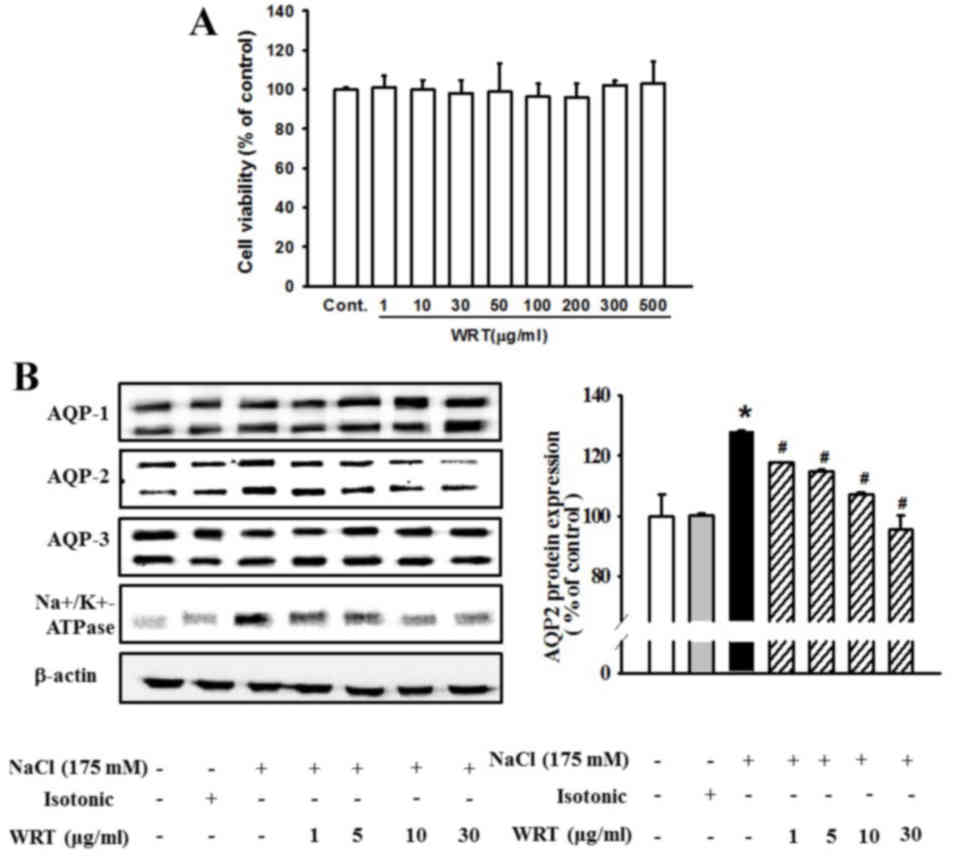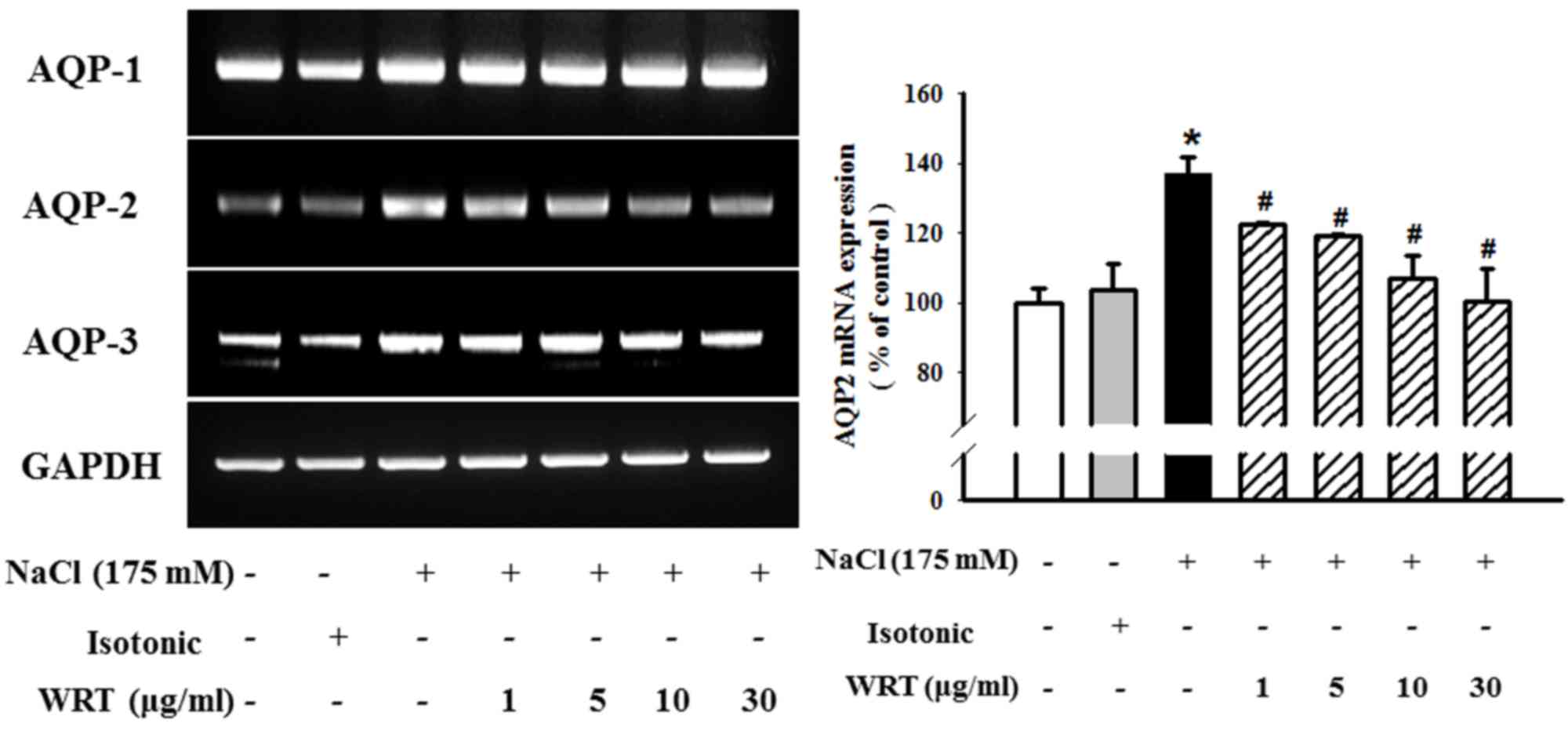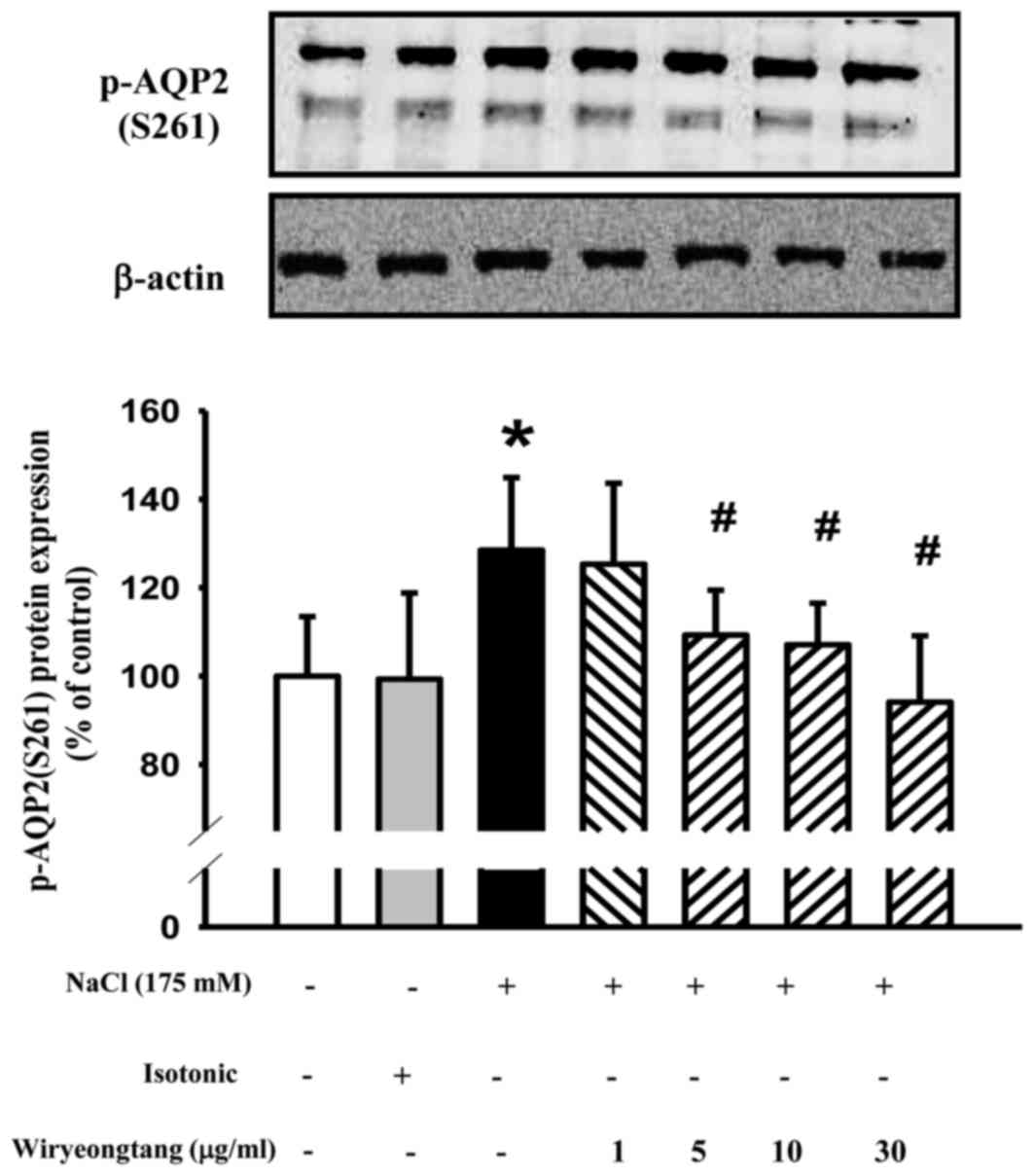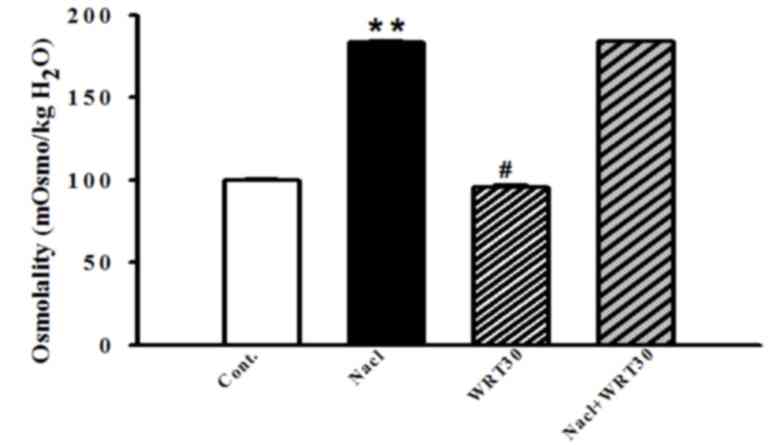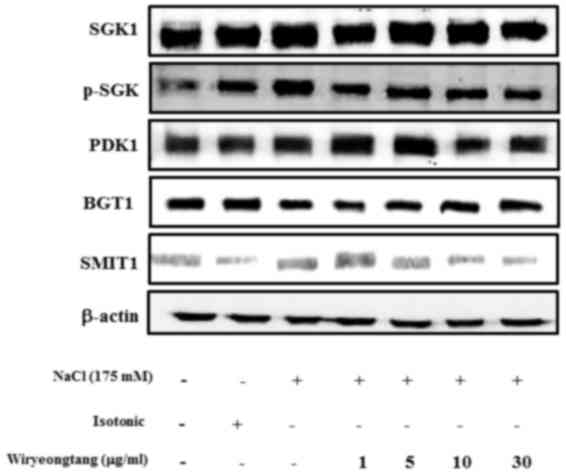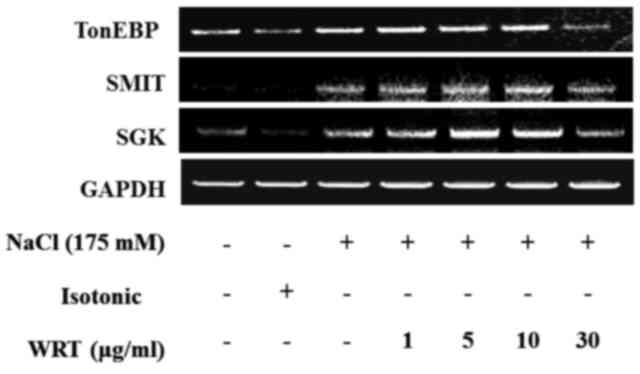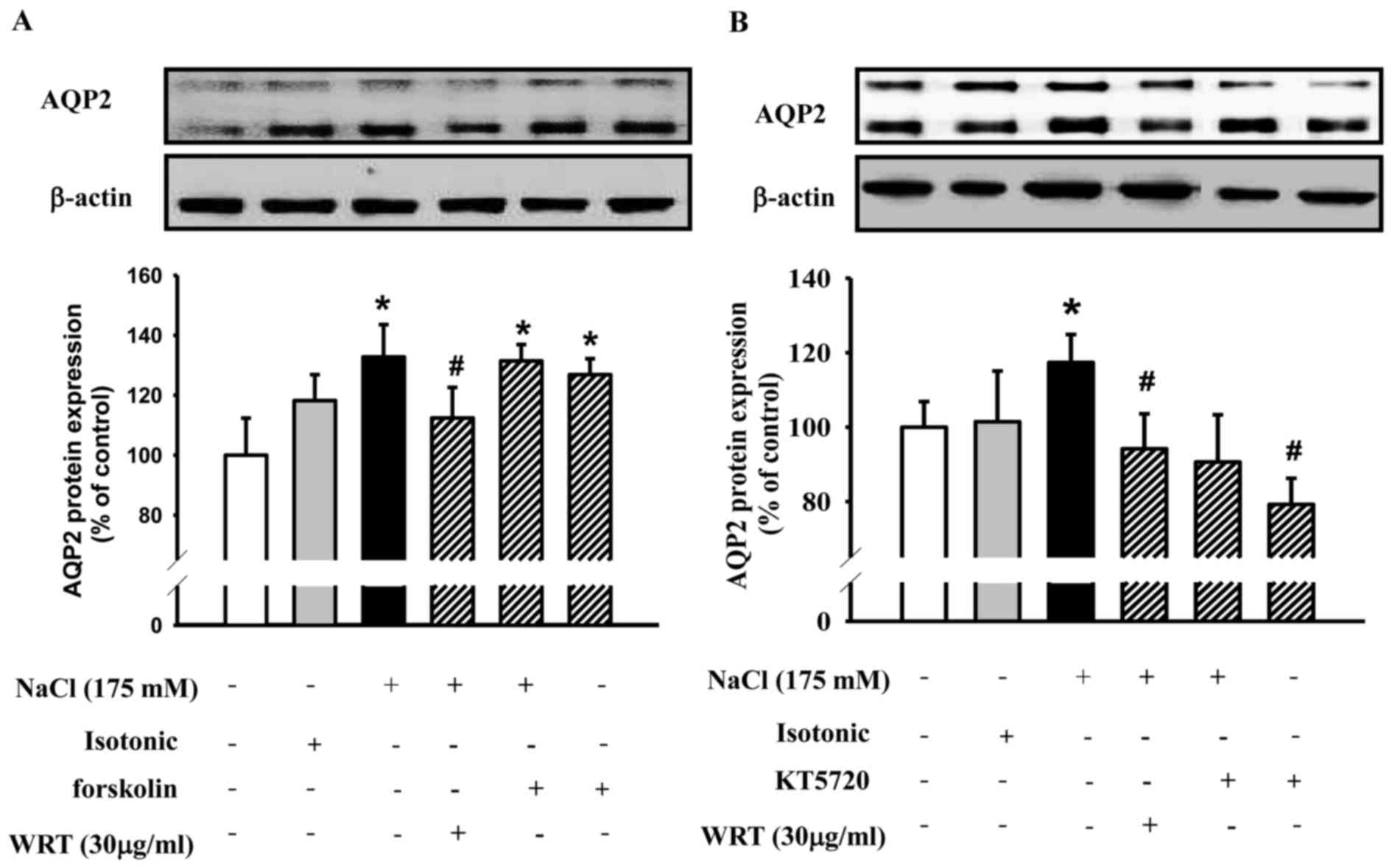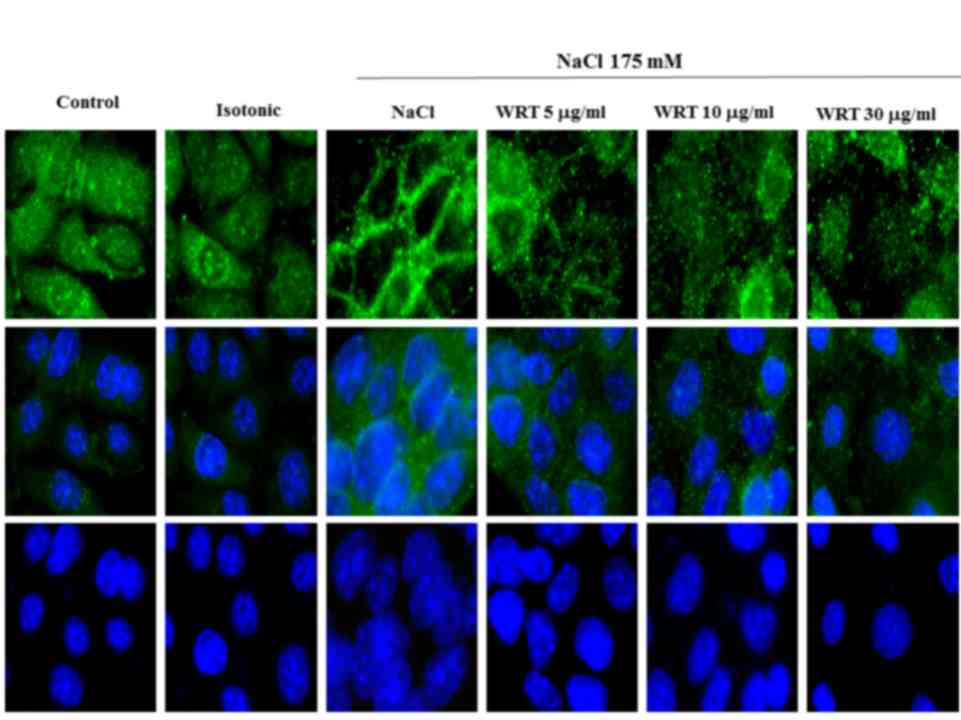Wiryeongtang regulates hypertonicity-induced expression of aquaporin-2 water channels in mIMCD-3 cells
- Authors:
- Published online on: March 7, 2017 https://doi.org/10.3892/mmr.2017.6296
- Pages: 2665-2672
Abstract
Introduction
The kidneys are important in the regulation of salt and water balance in the body. This function is finely regulated by the tubular reabsorption of body fluid through renal water and sodium channels, under the tight control of hormones, nerves and intracellular signaling pathways (1,2). Aquaporins (AQPs), expressed in the kidney, are divided based on pore selectivity into water-specific, orthodox aquaporins and solute-facilitating aquaglyceroporins, which conduct glycerol and urea (3,4). AQP2 is expressed in epithelial cells of the inner medullary collecting duct (IMCD) and are critical in urine concentrating mechanisms. The water permeability of the IMCD is rapidly regulated by the antidiuretic hormone, arginine vasopressin (AVP) (5). AVP binds to vasopressin V2 receptors, which are located predominantly in the basolateral plasma membrane of principal cells in collecting ducts. The activation of the V2 receptors causes stimulation of adenylyl cyclase via the G protein, Gs, leading to the elevation of cAMP. The subsequent activation of protein kinase A (PKA) initiates the translocation of AQP2-bearing vesicles from the cytosol to the plasma membrane, in which AQP2 is inserted via an exocytosis-like process and AQP2 phosphorylation is mediated by PKA (1,6). It has been suggested that AVP-mediated signaling pathways are involved in hypertonic stress-induced AQP trafficking in collecting ducts as the expression and targeting of AQP2 are regulated by hypertonic stress (7).
During antidiuresis, the IMCD adapts to the hyperosmotic interstitial environment by the increased expression of osmoprotective genes, which is driven by a common transcriptional activator, tonicity-responsive enhancer binding protein (TonEBP) (8). The accumulation of compatible osmolytes, including sorbitol, inositol, taurine, glycerophophorylcholine and betaine, is also essential for the survival of medullary cells under hypertonic conditions (9). Hyperosmotic stress stimulates the activation of serum- and glucocorticoid-inducible protein kinase 1 (Sgk1) via the p38 mitogen-activated protein kinase-dependent pathway (10,11). However, the complicated mechanisms induced by hypertonic stress remain to be fully elucidated.
Wiryeongtang (Wei-Ling-Tang, Magnolia and Hoelen combination; WRT), composed of pyeongwisan (Ping-Wei-San) and oryeongsan (Wu-Ling-San) (12,13), has been widely used in chronic edema and dysuresia of renal homeostasis, and was originally recorded in an ancient Korean medicinal book, ‘Donguibogam’ (14). WRT is composed of Alisma orientalis, Cinnamomum cassia, Atractylodes lancea, Magnolia officinalis, Paeonia lactiflora, Polyporus umbellatus, Poria cocos, Glycyrrhiza glabra and Citrus unshiu. However, the mechanism responsible for the effects of WRT against hypertonicity remains to be fully elucidated. Thus, the present study was performed to determine the possible effects of WRT on water channel regulation in response to hypertonic stress in mouse mIMCD-3 cells.
Materials and methods
Reagents
AQP1 (cat. no. sc-20810), AQP2 (cat. no. sc-28629), AQP3 (cat. no. sc-20811), Na+/K+ ATPase α1 (cat. no. sc-21712), p-SGK (cat. no. sc-16744), SGK (cat. no. sc-28338), 3-phosphoinositide-dependent kinase 1 (PDK1) (cat. no. sc-7140), β-actin (cat. no. sc-4778) antibodies were obtained from Santa Cruz Biotechnology, Inc. (Dallas, TX, USA). Anti-mouse (cat. no. ADI-SAB-100-J), anti-rabbit (cat. no. ADI-SAB-300-J), anti-goat (cat no. ADI-SAB-400-I) horseradish peroxidase (HRP)-conjugated secondary antibodies were purchased from Enzo Life Sciences, Inc. (Farmingdale, NY, USA). Forskolin (an adenylate cyclase activator) was purchased from Sigma-Aldrich; Merck Millipore (Darmstadt, Germany). KT5720 (a PKA inhibitor) was purchased from Alomone Labs, Ltd. (Jerusalem, Israel). The other reagents used in the present study were of the highest purity commercially available.
Preparation of WRT
The dried WRT was purchased from the Herbal Medicine Co-operative Association of Chonbuk Province (Chonbuk, Korea) in March 2010. A voucher specimen (no. HBI091) was deposited at the Hanbang Body-Fluid Research Center, Wonkwang University (Iksan, Korea). The ingredients of WRT comprised Alisma orientalis, Cinnamomum cassia, Atractylodes lancea, Magnolia officinalis, Paeonia lactiflora, Polyporus umbellatus, Poria cocos, Glycyrrhiza glabra and Citrus unshiu. The dried WRT (300 g) was boiled in 2 liters of distilled water for 2 h at 100°C. The aqueous extract was centrifuged at 890 × g for 20 min at 4°C and then concentrated using a rotary evaporator. The supernatant extract was lyophilized and the powder (yield rate, 1.77 g) was stored at 4°C until used in experiments.
Cell cultures
The mIMCD-3 cell line was originally acquired from American Type Culture Collection (Manassas, VA, USA) (2). The mIMCD-3 cells were routinely cultured in Dulbecco's modified Eagle's medium/F-12 supplemented with 10% FBS and antibiotics (Gibco and Invitrogen; Thermo Fisher Scientific, Inc., Waltham, MA, USA). mIMCD-3 cells in passages 9–11 were used and were maintained in mIMCD-3 medium in a humidified chamber containing 5% CO2 at 37°C.
Cell viability assay
Cell viability was determined using 3-(4,5-dimethylthinazol-2-yl)-2,3-diphenyl tetrazolium bromide (MTT) assay. mIMCD-3 was seeded into 96-well culture plates at a density of 1×104 cells/well. Following incubation with various concentrations of WRT (1–500 mg/ml) for 24 h, then 20 ml of MTT solution (0.5 mg/ml) was added to each culture well and further incubated at 37°C for 4 h. Following incubation for 4 h at 37°C, the MTT solution was removed and 200 ml of dimethyl sulfoxide (DMSO; Amresco, LLC, Solon, OH, USA) was added and mixtures were shaken, the crystals were fully dissolved for about 10 min. The absorbance of the dissolved formazan was read at 590 nm using a microplate reader (Multiskan, Thermo Fisher Scientific, Inc.). The absorbance was used as a measurement of cell viability, normalized to cells incubated in control medium, which were considered 100 % viable.
Measurements of osmolality
The mIMCD-3 cells were pretreated with WRT (1, 5, 10 and 30 g/ml) for 1 h, and stimulated with 175 mM NaCl for 1 h at 37°C. The supernatant, conditioned medium was collected by 210 × g at 4°C for 5 min for measurement of osmolality. Osmolality was measured using an Advanced osmometer (Model 3900; Advanced Instruments, Norwood, MA, USA).
Western blot analysis
Harvested cell pellet was lysed with RIPA lysis buffer. Following extraction, protein was quantified with Bradford method. Homogenates (40 mg total protein) was loaded on the gel for 10% SDS-polyacrylamide gel and transferred onto a nitrocellulose membrane. The blots were blocked with 5% non-fat milk and incubated with the appropriate primary antibody at dilutions (1:1,000) recommended by the manufacturer and incubated overnight at 4°C. The membrane was washed with TBST (0.1% Tween-20 in 1X TBS), and primary antibodies were detected with goat anti-rabbit-IgG or anti-mouse-IgG antibody conjugated to HRP, following which the bands were visualized with enhanced chemiluminescence (GE Healthcare Life Sciences, Chalfont, UK). Protein expression levels were determined by analyzing the signals captured on the nitrocellulose membranes using the ChemiDoc image analyzer version 4.0 (Bio-Rad Laboratories, Inc., Hercules, CA, USA).
Reverse transcription-polymerase chain reaction (RT-PCR) analysis
Total RNA isolation and RT-PCR analysis were performed using Maxime PCR PreMix (i-StarMAX II, Intron Biotechnology, Inc., Seongnam, South Korea) (2). cDNA was prepared from 500 ng RNA by reverse transcription in a final volume of 20 ml in an Opticon MJ Research instrument. The samples were incubated at 37°C for 60 min and 94°C for 5 min. The following sets of primers were used for PCR amplification: AQP1, sense 5′-GTCCCACATGGTCTAGCCTTGTCTG-3′ and antisense 5′-GGGAAGGGTCCTGGAGGTAAGTCA-3′; AQP2, sense 5′-TGCATCTTTGCCTCCACCGACGAG-3′ and antisense 5′-CATGGAGCAACCGGTGAAATAG-3′; AQP3, sense 5′-GGCTAAAAACGCTCCCTGTATCCA-3′ and antisense 5′-GGAGTTTCCCACCCCTATTCCTAAA-3′; SMIT, sense 5′-CACTGTGAGTGGATACTTCC-3′ and antisense 5′-TCTCTTAACTTCCTCAAACC-3′; Sgk1, sense 5′-GGAACACAGCCGAGATGTATGACAA-3′ and antisense 5′-AACTGCTTCCGCGGCTTCTTTCACAC-3′; TonEBP, sense 5′-ATGCAATTTCAGAATCAGCC-3′ and antisense 5′-GCATTTGCGAGAAAGAAG-3′; GAPDH, sense 5′-TCACCATCTTCCAGGAGCGAG-3′ and antisense 5′-AAGGTGCAGAGATGATGACCCTC-3′. Synthesized cDNA 1 µl, 50 nM each primer, butters were placed up to 20 µl in the PCR Pre-mix according to the manufacturer's protocol (Intron Biotechnology, Inc.). The amplification profile was as follows: Initial cycling at 94°C for 15 min, followed by 45 cycles of 94°C for 20 sec, 60°C for 20 sec, 72°C for 30 sec, and a final extension step at 72°C for 5 min. The PCR products were subjected to 1.2% agarose gel electrophoresis.
Immunofluorescence
The mIMCD-3 cells were seeded at a density of 1×106 cells/well on sterile slide coverslips in a 60 mm culture dish and treated with 175 mM NaCl, with or without WRT (5, 10 and 30 µg/ml), for 1 h at 37°C. Following incubation, the medium was removed and the cells were fixed with 4% PFA in PBS at room temperature for 5 min, and permeabilized with 0.1% Triton X-100 in PBS for 15 min, as described previously (15). The cells were overlaid with 1% BSA (Santa Cruz Biotechnology, Inc.) in PBS, and then incubated with AQP2 antibody (1:100, Santa Cruz Biotechnology, Inc.) incubated at 4°C overnight. The cells were then incubated with FITC green-conjugated rabbit anti-goat IgG secondary antibody (1:1,000, cat. no. A11078, Invitrogen; Thermo Fisher Scientific, Inc.). The slides were incubated at room temperature for 1 h, and nucleus staining was performed with 4′,6-diamino-2-phenylindole (Molecular Probes; Thermo Fisher Scientific, Inc.) diluted 1:500 in PBS. Coverslips were mounted with mounting medium, ProLong®Gold antifade reagents (Molecular Probes; Thermo Fisher Scientific, Inc.) onto glass slides and examined using fluorescence microscopy (ECLIPSETi; Nikon Corporation; Tokyo, Japan).
Statistical analysis
The results are expressed as the mean ± standard error of the mean. The statistical significance of differences between group means was determined using one-way analysis of variance and Student's t-test using Sigma Plot version 10.0 (Systat Software, Inc., San Jose, CA, USA). P<0.05 was considered to indicate a statistically significant difference.
Results
Effect of WRT on hypertonic stress-induced regulation of AQP2
To assess the effect of WRT on cytotoxicity in mIMCD-3 cells, the cells were incubated with WRT (1–500 µg/ml) for 24 h, and an MTT assay was performed. WRT show no cytotoxicity at various concentrations (Fig. 1A). Therefore, 30 µg/ml of WRT was used as the maximum dose in the present study. Pretreatment with WRT significantly decreased the hypertonic stress-induced expression of AQP2 (Fig. 1B). However, the expression levels of AQP1 and AQP3 were not altered significantly by hypertonic stress. The level of hypertonic stress-induced Na,K-ATPase α1-subunit was also decreased by WRT pretreatment. In addition, the mRNA levels of AQP1, AQP2 and AQP3 were measured using RT-PCR analysis. As shown in Fig. 2, pretreatment with WRT (1–30 µg/ml) markedly decreased hypertonic stress-induced mRNA levels of AQP2. However, no differences in AQP1 or AQP3 were observed between the hypertonic-stress group and WRT group. Alterations in the mRNA levels corresponded closely to the alterations in protein levels.
In addition to mediating expression, hypertonic stress mediates the phosphorylation of AQP2. Pretreatment with WRT (1–30 µg/ml) for 30 min decreased the hypertonic stress-induced phosphorylation of AQP2 (Fig. 3).
Effect of WRT on alterations in osmolality under hypertonic stress
To examine whether osmotic alterations occurred, the osmolality of the medium was measured. mIMCD-3 cells were pretreated with WRT (1–30 µg/ml) for 30 min, and stimulated with NaCl (175 mM) for 1 h. The osmolality was significantly increased by hypertonic stress. WRT alone also altered osmolality, however, WRT did not affect the osmolality of the NaCl-treated group (Fig. 4).
Effect of WRT on hypertonic stress-induced SGK1 and TonEBP
SGK1 is a signaling kinase, which is induced by hypertonicity. Therefore, the inhibitory effect of WRT on the hypertonic stress-induced expression of SGK1 was examined. As shown in Fig. 5, hypertonicity was associated with the phosphorylation of SGK1, However, WRT attenuated the hypertonic stress-induced phosphorylation of Sgk1 in a dose-dependent manner. To evaluate alterations in the activity of SGK1, SMIT and TonEBP, mRNA expression levels were measured in the mIMCD-3 cells. Confluent mIMCD-3 cells were pretreated with WRT and then treated with 175 mM NaCl. Hypertonic stress increased the mRNA levels of SGK1, SMIT and TonEBP. However, WRT decreased these mRNA expression levels in a dose-dependent manner (Fig. 6).
Involvement of the PKA signaling pathways on the inhibitory effects of WRT in hypertonic stress-induced expression of AQP2
To clarify the involvement of PKA signaling pathways on the inhibitory effects of WRT in the hypertonic stress-induced expression of AQP2, the mIMCD-3 cells were pretreated with KT5720, a cell permeable-specific competitive inhibitor of PKA, or with WRT, and then treated with 175 mM NaCl. Following treatment with forskolin, an adenylate cyclase activator, the expression of AQP2 was markedly enhanced (Fig. 7A). The results showed that pretreatment with WRT exhibited a similar effect to KT5720, which decreased the hypertonic stress-induced expression of AQP2 (Fig. 7B).
Effect of WRT on hypertonic stress-induced increase of AQP2 trafficking
Hypertonic stress-induced water osmosis is dependent on the insertion of vesicles containing AQP2 into the apical membrane. To determine whether WRT decreases hypertonic stress-induced trafficking of AQP2 to the apical membrane, immunofluorescence was performed. As shown in Fig. 8, AQP2 was predominantly located intracellularly in the control or isotonic-treated cells. Following stimulating hypertonic stress-induced cells with 175 mM NaCl, AQP2 was localized to the apical membrane. However, pretreatment with WRT decreased NaCl- induced AQP2 trafficking in mIMCD-3 cells.
Discussion
WRT is a well-known traditional oriental medicine used for the treatment of chronic edema, dysuresia and water imbalance during in vitro hypertonic stress. WRT has a beneficial effect on inhibiting the PKA-mediated expression of AQP2 water channels and accumulation of organic osmolytes under hypertonic stress.
The osmotic gradient is required to drive the reabsorption of water from the renal collecting ducts (16). Hypertonic stress (175 mM NaCl) increased the expression levels of AQP2 in mIMCD-3 cells. Under hypertonic conditions, the activation of cation channels and osmolyte transport systems is possibly the most important mechanism to prevent osmotic cell shrinkage (17). The major organic osmolytes found in mammalian renal medulla consist of myo-inositol, betaine, sorbitol, taurine and glycerphosphorylcholine. Several of these are actively transported into the cell by membrane transporters, including the sodium/myo-inositol cotransporter (SMIT), sodium/chloride/betaine cotransporter (BGT1) and sodium/chloride/taurine cotransporter (TauT). Sorbitol is synthesized from glucose by aldose reductase (AR) (17). When cultured cells are exposed to hypertonic conditions, the activity of AR is upregulated and transporters lead to the cellular accumulation of organic osmolytes. In the present study, the osmolyte-associated protein expression of BGT1 was determined using western blot analysis. However, pretreatment with WRT did not affect the expression of BGT1.
The TonE/TonEBP pathway mediates tonicity-responsive transcriptional regulation by stimulating the urea transporters and possibly the AQP2 water channel (18,19). TonEBP is an essential regulator in the urine concentrating mechanism. In the present study, pretreatment with WRT decreased the protein and mRNA expression levels of TonEBP and SMIT. Thus, WRT regulated hypertonic stress-induced urine concentration via the TonEBP signaling pathway in the IMDC. SGK, an aldosterone-induced gene in mineralocorticoid target cells, regulates the epithelial sodium channel. SGK activation by aldosterone is mediated through mineralocorticoid receptors (MRs) (20).
ENaC transports Na+ and is essential for salt and fluid homeostasis across epithelial tissues. Aldosterone also causes the translocation of MR to the nucleus and the phosphorylation of SGK-1 (21). The functions of SGK and PKA are well understood and are known to upregulate the activity of ENaC (22). SGK1 is known to be regulated by hypertonic stress. In the present study, the mRNA expression of SGK and protein and mRNA expression levels of phosphorylated-SGK were decreased by WRT pretreatment in a dose-dependent manner. These results demonstrated that WRT regulated SGK1-mediated sodium channels against hypertonic stimulation, although there was no direct evidence that ENaC was regulated by WRT in the IMDC. Thus, further investigation is required to clarify the mechanism underlying the effect of WRT in hypertonic stress-induced natriuresis.
AQPs are a family of specialized water channels expressed on heterogeneous cell types, of which at least three major types are found in the central nervous system (23,24). The AQP1 water channel is expressed in the proximal tubule and thin descending limb of the loop of Henle (25). AQP3 and AQP4 are present in the basolateral plasma membrane of collecting duct principal cells and represent exit pathways for water reabsorbed apically via AQP2. In addition, vasopressin regulates the osmotic transport of water (26). Under hypertonic stress, treatment with 175 mM NaCl (650 mosmol/kg) induced the expression of AQP2 and transport to the apical membrane, demonstrating that the renal collecting duct was involved in urine concentration.
Vasopressin promotes renal water reabsorption, decreasing the excretion of free water to dilute plasma and lower serum osmolality. Vasopressin is the primary hormone regulating water conservation in mammals. The apical accumulation of AQP2 is mediated by vasopression, a water channel protein, thus facilitating water reabsorption by the kidney. Vasopressin binds to the V2 receptor of IMCD cells, activates the heterotrimeric G protein Gαs and stimulates adenylyl cyclases III and VI, which convert ATP into cAMP (27). Increased cAMP levels activate cAMP-dependent PKA and lead to phosphorylation (27). PKA is critical in water excretion through regulation of the production and action of the antidiuretic hormone, vasopressin (28). AQP2 channels are then phosphorylated and are rapidly redistributed from intracellular vesicles to the apical membrane of collecting duct principal cells (29). In hypertonic conditions, pretreatment with WRT decreased the protein and mRNA expression levels of AQP2. The Na,K-ATPase α1-subunit in basolateral membrane was also regulated by WRT. These results suggested that WRT decreased AQP2 trafficking to the membrane through inhibition of cAMP/PKA signaling pathway and direct/indirect involvement of TonEBP under hypertonic stress in mIMCD-3 cells. In addition, it was suggested that the pathophysiology of hypertonic stress-induced AQP2 was not limited to the ‘classical’ cAMP/PKA pathway in mIMCD-3 cells.
Forskolin, an adenylate cyclase activator, increases intracellular levels of cAMP in a variety of cells (12,30). In the present study, WRT decreased hypertonic stress-induced levels of cAMP in a dose-dependent manner. Forskolin increased the expression of AQP2 with/without NaCl stimulation. WRT exhibited a similar effect as the PKA inhibitor, KT5720, which decreased the hypertonic stress-induced expression of AQP2 suggesting that WRT inhibited hypertonic stress-induced expression of AQP2 via the classical cAMP/PKA pathway in mIMCD-3 cells (31).
In conclusion, pretreatment of cells with WRT decreased the hypertonic stress-induced phosphorylation of SGK. As a result, the phosphorylation of AQP2 was decreased and this led to increased urine volume. Taken together, the implications of the present study in IMCD cells were that WRT had the beneficial effect in regulating water balance against in vitro hypertonic stress. The classical cAMP/PKA and TonEBP/SGK1 signaling pathways were involved in hypertonic stress-induced expression of AQP2. Thus, WRT may inhibit these signaling pathways, resulting in the regulation of renal homeostasis.
Acknowledgements
This study was supported by the National Research Foundation of Korea grant funded by the Korean Government (MSIP; grant no. 2008–0062484).
References
|
Klussmann E, Maric K and Rosenthal W: The mechanisms of aquaporin control in the renal collecting duct. Rev Physiol Biochem Pharmacol. 141:33–95. 2000. View Article : Google Scholar : PubMed/NCBI | |
|
Lee SM, Lee YJ, Yoon JJ, Kang DG and Lee HS: Effect of Poria cocos on hypertonic stress-induced water channel expression and apoptosis in renal collecting duct cells. J Ethnopharmacol. 141:368–376. 2012. View Article : Google Scholar : PubMed/NCBI | |
|
Day RE, Kitchen P, Owen DS, Bland C, Marshall L, Conner AC, Bill RM and Conner MT: Human aquaporins: Regulators of transcellular water flow. Biochim Biophys Acta. 1840:1492–1506. 2014. View Article : Google Scholar : PubMed/NCBI | |
|
Nielsen S, Frøkiaer J, Marples D, Kwon TH, Agre P and Knepper MA: Aquaporins in the kidney: From molecules to medicine. Physiol Rev. 82:205–244. 2002. View Article : Google Scholar : PubMed/NCBI | |
|
Storm R, Klussmann E, Geelhaar A, Rosenthal W and Maric K: Osmolality and solute composition are strong regulators of AQP2 expression in renal principal cells. Am J Physiol Renal Physiol. 284:F189–F198. 2003. View Article : Google Scholar : PubMed/NCBI | |
|
Hozawa S, Holtzman EJ and Ausiello DA: cAMP motifs regulating transcription in the aquaporin 2 gene. Am J Physiol. 270:C1695–C1702. 1996.PubMed/NCBI | |
|
Umenishi F, Narikiyo T, Vandewalle A and Schrier RW: cAMP regulates vasopressin-induced AQP2 expression via protein kinase A-independent pathway. Biochim Biophys Acta. 1758:1100–1105. 2006. View Article : Google Scholar : PubMed/NCBI | |
|
Hasler U, Jeon US, Kim JA, Mordasini D, Kwon HM, Féraille E and Martin PY: Tonicity-responsive enhancer binding protein is an essential regulator of aquaporin-2 expression in renal collecting duct principal cells. J Am Soc Nephrol. 17:1521–1531. 2006. View Article : Google Scholar : PubMed/NCBI | |
|
Kwon ED, Jung KY, Edsall LC, Kim HY, García-Pérez A and Burg MB: Osmotic regulation of synthesis of glycerol phosphocholine from phosphatidylcholine in MDCK cells. Am J Physiol. 268:C402–C412. 1995.PubMed/NCBI | |
|
Bell LM, Leong ML, Kim B, Wang E, Park J, Hemmings BA and Firestone GL: Hyperosmotic stress stimulates promoter activity and regulates cellular utilization of the serum- and glucocorticoid-inducible protein kinase (Sgk) by a p38 MAPK-dependent pathway. J Biol Chem. 275:25262–25272. 2000. View Article : Google Scholar : PubMed/NCBI | |
|
Chen S, Grigsby CL, Law CS, Ni X, Nekrep N, Olsen K, Humphreys MH and Gardner DG: Tonicity-dependent induction of Sgk1 expression has a potential role in dehydration-induced natriuresis in rodents. J Clin Inves. 119:1647–1658. 2009. View Article : Google Scholar | |
|
Riedlinger JE, Tan PW and Lu W: Ping wei san, a Chinese medicine for gastrointestinal disorders. Ann Pharmacother. 35:228–235. 2001. View Article : Google Scholar : PubMed/NCBI | |
|
Lin E, Ho L, Lin MS, Huang MH and Chen WC: Wu-Ling-San formula prophylaxis against recurrent calcium oxalate nephrolithiasis-a prospective randomized controlled trial. Afr J Tradit Complement Altern Med. 10:199–209. 2013.PubMed/NCBI | |
|
Yun GY: Oriental Herbal Formula Science. Publisher myeongbo; Seoul: pp. 198–204. 1985 | |
|
Lee YP, Lee YJ, Lee SM, Yoon JJ, Kim HY, Kang DG and Lee HS: Effect of atractylodes macrocephala on hypertonic stress-induced water channel protein expression in renal collecting duct cells. Evid Based Complement Alternat Med. 2012:6508092012. View Article : Google Scholar : PubMed/NCBI | |
|
Knepper MA, Kwon TH and Nielsen S: Molecular physiology of water balance. N Engl J Med. 372:1349–1358. 2015. View Article : Google Scholar : PubMed/NCBI | |
|
Wehner F: Cell volume-regulated cation channels. Contrib Nephrol. 152:25–53. 2006. View Article : Google Scholar : PubMed/NCBI | |
|
Jeon US, Kim JA, Sheen MR and Kwon HM: How tonicity regulates genes: Story of TonEBP transcriptional activator. Acta Physiol (Oxf). 187:241–247. 2006. View Article : Google Scholar : PubMed/NCBI | |
|
Nakayama Y, Peng T, Sands JM and Bagnasco SM: The TonE/TonEBP pathway mediates tonicity-responsive regulation of UT-A urea transporter expression. J Biol Chem. 275:38275–38280. 2000. View Article : Google Scholar : PubMed/NCBI | |
|
Náray-Fejes-Tóth A and Fejes-Tóth G: The sgk, an aldosterone induced gene in mineralocorticoid target cells, regulates the epithelial sodium channel. Kidney Int. 57:1290–1294. 2000. View Article : Google Scholar : PubMed/NCBI | |
|
Salyer SA, Parks J, Barati MT, Lederer ED, Clark BJ, Klein JD and Khundmiri SJ: Aldosterone regulates Na(+), K(+) ATPase activity in human renal proximal tubule cells through mineralocorticoid receptor. Biochim Biophys Acta. 1833:2143–2152. 2013. View Article : Google Scholar : PubMed/NCBI | |
|
Baines D: Kinases as targets for ENaC regulation. Curr Mol Pharmacol. 6:50–64. 2013. View Article : Google Scholar : PubMed/NCBI | |
|
Vella J, Zammit C, Di Giovanni G, Muscat R and Valentino M: The central role of aquaporins in the pathophysiology of ischemic stroke. Front Cell Neurosci. 9:1082015. View Article : Google Scholar : PubMed/NCBI | |
|
Tait MJ, Saadoun S, Bell BA and Papadopoulos MC: Water movements in the brain: Role of aquaporins. Trends Neurosci. 31:37–43. 2008. View Article : Google Scholar : PubMed/NCBI | |
|
Zhai XY, Fenton RA, Andreasen A, Thomsen JS and Christensen EI: Aquaporin-1 is not expressed in descending thin limbs of short-loop nephrons. J Am Soc Nephrol. 18:2937–2944. 2007. View Article : Google Scholar : PubMed/NCBI | |
|
van Balkom BW, van Raak M, Breton S, Pastor-Soler N, Bouley R, van der Sluijs P, Brown D and Deen PM: Hypertonicity is involved in redirecting the aquaporin-2 water channel into the basolateral, instead of the apical, plasma membrane of renal epithelia cells. J Biol Chem. 278:1101–1107. 2003. View Article : Google Scholar : PubMed/NCBI | |
|
Boone M and Deen PM: Physiology and pathophysiology of the vasopressin-regulated renal water reabsorption. Pflugers Arch. 456:1005–1024. 2008. View Article : Google Scholar : PubMed/NCBI | |
|
Gilbert ML, Yang L, Su T and McKnight GS: Expression of a dominant negative PKA mutation in the kidney elicits a diabetes insipidus phenotype. Am J Physiol Renal Physiol. 308:F627–F638. 2015. View Article : Google Scholar : PubMed/NCBI | |
|
Breyer JA, Bain RP, Evans JK, Nahman NS Jr, Lewis EJ, Cooper M, McGill J and Berl T: Predictors of the progression of renal insufficiency patients with insulin-dependent diabetes and overt diabetic nephropathy the collaborative study group. Kidney Int. 50:1651–1658. 1996. View Article : Google Scholar : PubMed/NCBI | |
|
Hoyer PB, Fitz TA and Niswender GD: Hormone-independent activation of adenylate cyclase in large steroidogenic ovine luteal cells does not result in increased progesterone secretion. Endocrinology. 114:604–608. 1984. View Article : Google Scholar : PubMed/NCBI | |
|
Yip KP and Sham JS: Mechanisms of vasopressin-induced intracellular Ca2+ oscillations in rat inner medullary collecting duct. Am J Physiol Renal Physiol. 300:F540–F548. 2011. View Article : Google Scholar : PubMed/NCBI |



